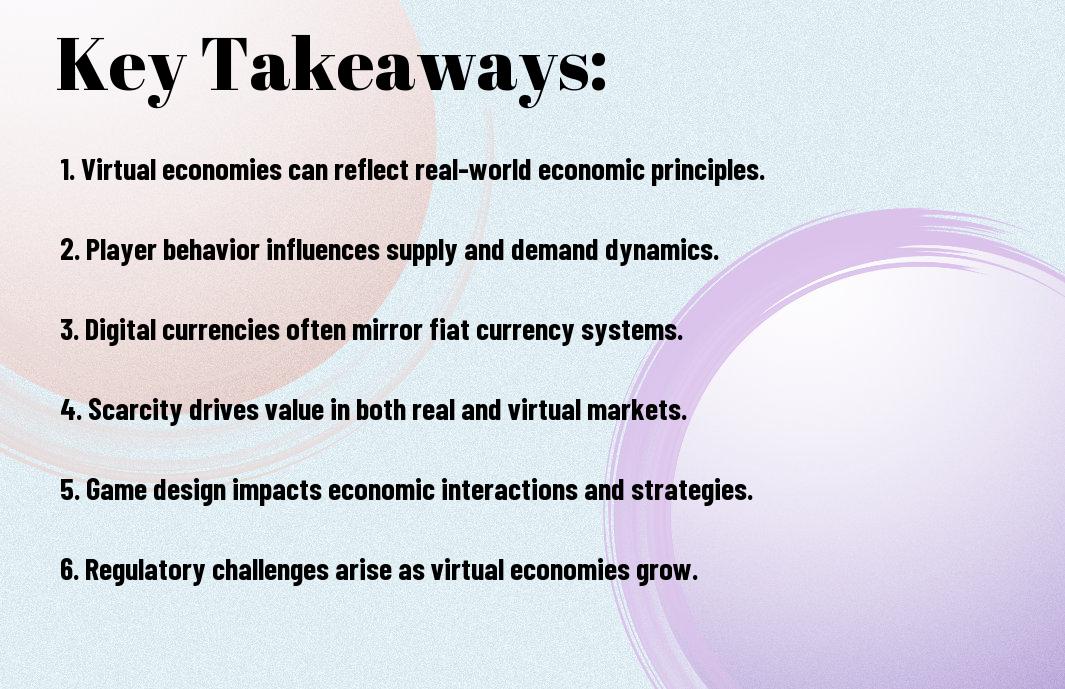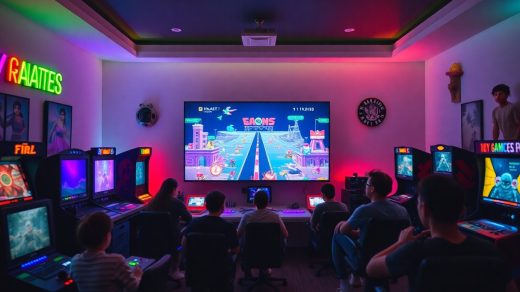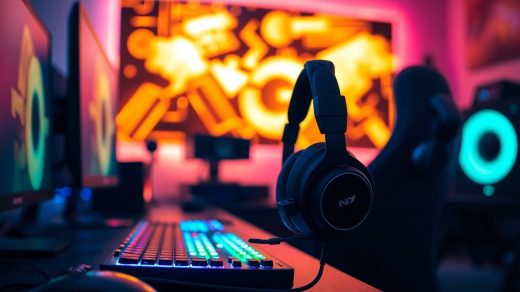As you explore the vast virtual worlds of online games, you may notice that the economies within them are surprisingly similar to those in the real world. You can buy, sell, and trade virtual goods, and even participate in complex market dynamics. But have you ever wondered how these economies work? To learn more about the intricacies of virtual markets, you can visit this resource on How does the economy in video games work? to gain a deeper understanding of your virtual financial dealings.
Key Takeaways:
- In-game economies can mirror real-world markets, with virtual goods and currencies being bought and sold, and players engaging in trade and commerce.
- These virtual markets can be influenced by supply and demand, just like real-world economies, and can be subject to inflation, deflation, and other economic phenomena.
- The value of virtual goods and currencies can fluctuate, and players may use real money to purchase in-game items or currency, blurring the line between the virtual and real economies.
- In-game economies can also be affected by external factors, such as changes in the game’s design or updates, which can impact the value of virtual goods and currencies.
- Some games have even spawned real-world industries, such as gold farming, where players are paid to accumulate in-game currency or items, which are then sold to other players.
- The study of in-game economies can provide insights into human behavior and economic decision-making, as well as the potential for virtual worlds to inform and reflect real-world economic systems.
- The intersection of virtual and real-world economies raises important questions about the regulation and governance of in-game markets, and the potential for exploitation or manipulation by game developers or other actors.

Virtual Currency Systems
A key aspect of in-game economies is the virtual currency system, which you can learn more about in articles such as Economics in the Age of AI: Are Bot-Run Game Economies the Real Deal, to understand how these systems work and their implications on your gaming experience.
Digital Money Creation
About the creation of digital money, you should know that it is a process that involves generating new currency units, which can be used to purchase in-game items or services, and this process is typically controlled by the game developers.
Exchange Rate Mechanisms
An necessary component of virtual currency systems is the exchange rate mechanism, which determines the value of your virtual currency in relation to other currencies, and this can significantly impact your ability to acquire the items you need.
With exchange rate mechanisms, you have the ability to exchange your virtual currency for other currencies or items, and this can be done through various methods, such as trading with other players or using in-game exchange services, and understanding how these mechanisms work is vital to making the most of your in-game economy experience.

Market Forces in Gaming
While exploring in-game economies, you’ll notice that market forces play a significant role in shaping your experience. You’ll encounter virtual markets that mirror real-world economic principles, influencing the value of items and resources.
Supply and Demand Dynamics
On closer inspection, you’ll see that supply and demand dynamics drive the economy, affecting the prices of goods and services. You’ll observe how your actions, along with those of other players, impact the market.
Player-Driven Price Fluctuations
One notable aspect of in-game economies is the fluctuation of prices, driven by player interactions. You’ll experience firsthand how your purchases and sales influence the market, causing prices to rise or fall.
Indeed, as you participate in these economies, you’ll notice that player-driven price fluctuations can have significant effects on your gameplay. You’ll need to adapt to changing market conditions, making strategic decisions about when to buy or sell items, and how to maximize your in-game wealth. Your understanding of these dynamics will help you navigate the virtual market and make the most of your gaming experience.
Trading Platforms
Now, as you investigate into the world of in-game economies, you’ll notice the emergence of trading platforms that facilitate the exchange of virtual goods and services. These platforms enable you to buy, sell, and trade items, often with real-world currency. You can participate in these markets, interacting with other players and shaping the economy.
In-Game Marketplaces
Beneath the surface of these economies, you’ll find in-game marketplaces where you can purchase items, such as weapons, armor, and other virtual goods. You can browse these marketplaces, comparing prices and making informed decisions about your purchases, much like you would in a real-world market.
External Trading Networks
Adjacent to in-game marketplaces, you’ll discover external trading networks that allow you to trade items with other players outside of the game. You can use these networks to acquire rare or hard-to-find items, often for a premium price, and expand your in-game inventory.
External trading networks offer you a range of benefits, including access to a broader range of items and the ability to trade with players from around the world. You can use these networks to fill gaps in your inventory, acquire items that are rare or unavailable in-game, and even make a profit by buying and selling items at the right price. As you participate in these networks, you’ll gain a deeper understanding of the in-game economy and develop strategies to maximize your trading success.
Economic Behaviors
Your in-game actions reflect real-world economic principles, as you make decisions based on supply and demand, risk, and reward.
Virtual Consumer Psychology
Against the backdrop of virtual markets, you observe behaviors that mirror real-life consumer psychology, with players making purchasing decisions based on perceived value and social influence.
Investment Patterns
To better understand in-game economies, you examine investment patterns, where players allocate resources to maximize returns, often taking calculated risks to achieve their goals.
Understanding these investment patterns helps you see how players optimize their in-game wealth, making informed decisions about where to invest time and resources, and how to navigate the virtual market’s fluctuations, ultimately reflecting your own economic behaviors and decision-making processes.
Real-World Parallels
Despite the virtual nature of in-game economies, you’ll find that they often mirror real-world economic principles, allowing you to experience and understand complex concepts in a unique way. As you explore these economies, you’ll notice similarities between virtual and real-world markets, making them a fascinating area of study.
Inflation and Deflation
Betwixt the lines of code and virtual transactions, you’ll discover that in-game economies can suffer from inflation and deflation, just like real-world economies, affecting the value of your virtual currency and assets.
Market Crashes and Booms
Prior to exploring into the world of in-game economies, you might not expect to encounter market crashes and booms, but they can and do occur, impacting your in-game wealth and progress.
To better understand market crashes and booms in in-game economies, you should consider the factors that contribute to these events, such as changes in game mechanics, updates, or shifts in player behavior, and how they can affect your overall gaming experience, allowing you to navigate these virtual markets with greater awareness and insight.
Regulatory Aspects
For your understanding of in-game economies, it’s crucial to consider the regulatory aspects that shape these virtual markets, as you navigate the complexities of online gaming.
Game Developer Controls
With strict guidelines in place, you’ll find that game developers exert significant control over in-game economies, influencing your experience and the overall market dynamics.
Real-Money Trading Policies
Game publishers establish policies governing real-money trading, affecting how you buy and sell virtual items, and you must adhere to these rules to avoid penalties.
In addition, as you engage with real-money trading, you should be aware that these policies can vary greatly between games, and it’s your responsibility to understand the specific rules and regulations that apply to your favorite games, ensuring a safe and enjoyable experience.
Summing up
Hence, as you investigate into in-game economies, you notice that virtual markets mirror reality in surprising ways. You see that your interactions within these digital worlds are influenced by real-world economic principles. Your understanding of these dynamics allows you to navigate and participate in these economies more effectively, making your gaming experience more enjoyable and immersive. You begin to appreciate the complexity of these virtual markets and how they reflect your own economic behaviors.
FAQ
Q: What are in-game economies and how do they mirror reality?
A: In-game economies refer to the systems of production, distribution, and exchange of virtual goods and services within online games. These economies can mirror reality in several ways, such as the existence of supply and demand, inflation, and even economic bubbles. Just like in the real world, in-game economies can be influenced by factors such as player behavior, game design, and external events. For example, a highly sought-after virtual item can drive up its price, while an oversupply of a particular resource can lead to deflation. Understanding these dynamics can help game developers create more realistic and engaging game worlds.
Q: How do virtual markets in online games affect the real-world economy?
A: Virtual markets in online games can have a significant impact on the real-world economy. For instance, the trade of virtual goods and currencies can lead to the creation of new jobs, such as professional gamers, streamers, and virtual item traders. Additionally, the sale of in-game items and currencies can generate substantial revenue for game developers and publishers. Furthermore, the study of in-game economies can provide valuable insights into human behavior and economic decision-making, which can be applied to real-world economic systems. However, there are also concerns about the potential negative impacts, such as the exploitation of players and the facilitation of illegal activities like money laundering.
Q: What are some of the challenges and opportunities associated with regulating in-game economies?
A: Regulating in-game economies can be a complex and challenging task, as it requires balancing the needs of game developers, players, and governments. One of the main challenges is ensuring that in-game economies do not facilitate illegal activities, such as money laundering or gambling, while also allowing players to engage in legitimate economic activities. Opportunities for regulation include creating frameworks for the safe and secure trade of virtual goods and currencies, as well as providing guidance on issues like taxation and consumer protection. Effective regulation can help to promote healthy and sustainable in-game economies, which can in turn contribute to the growth and development of the gaming industry as a whole.



